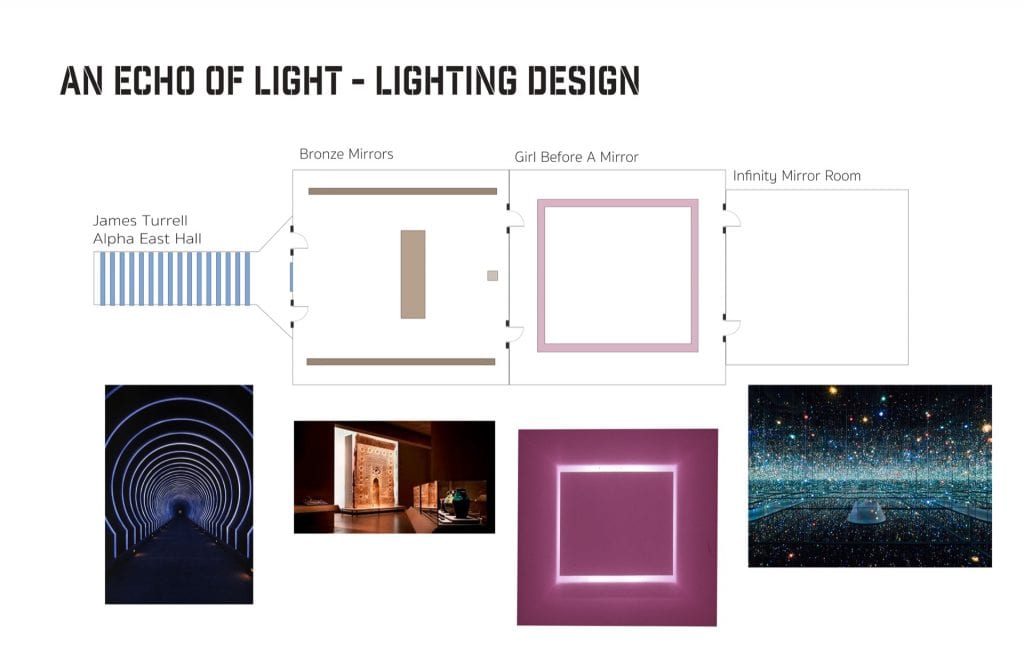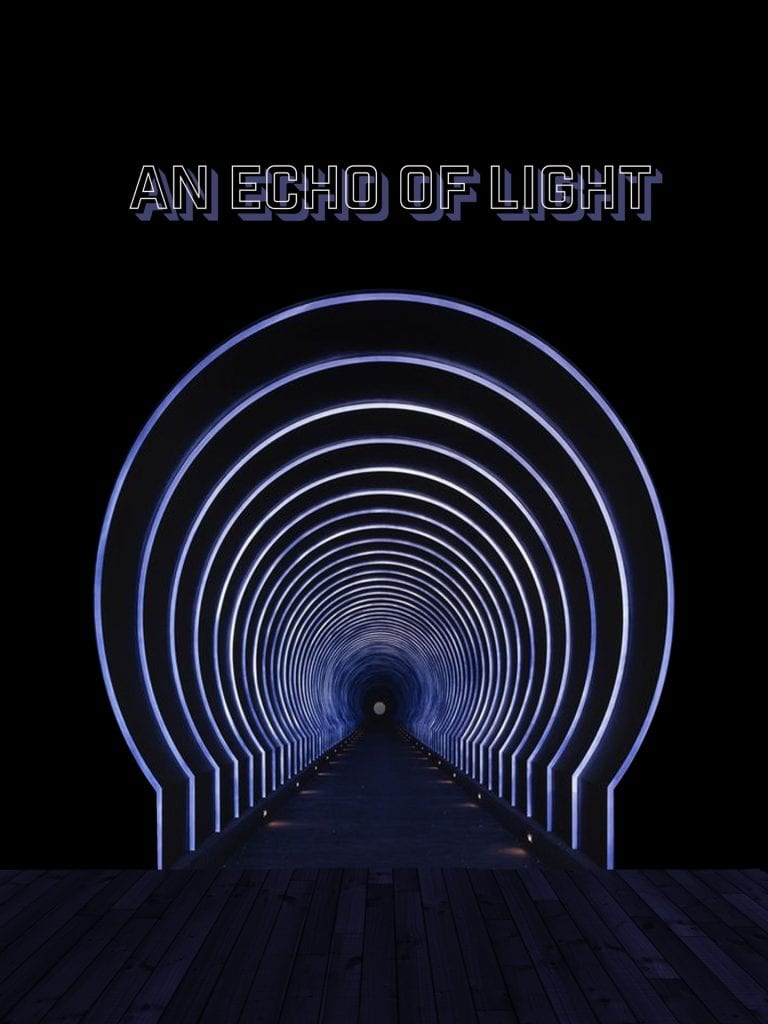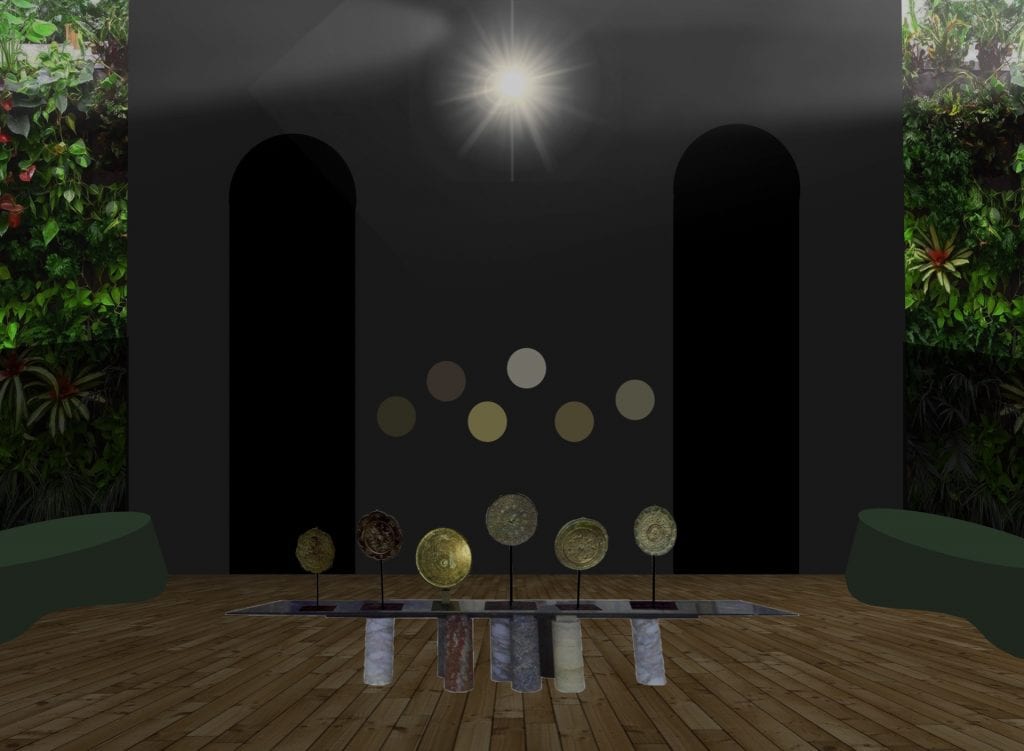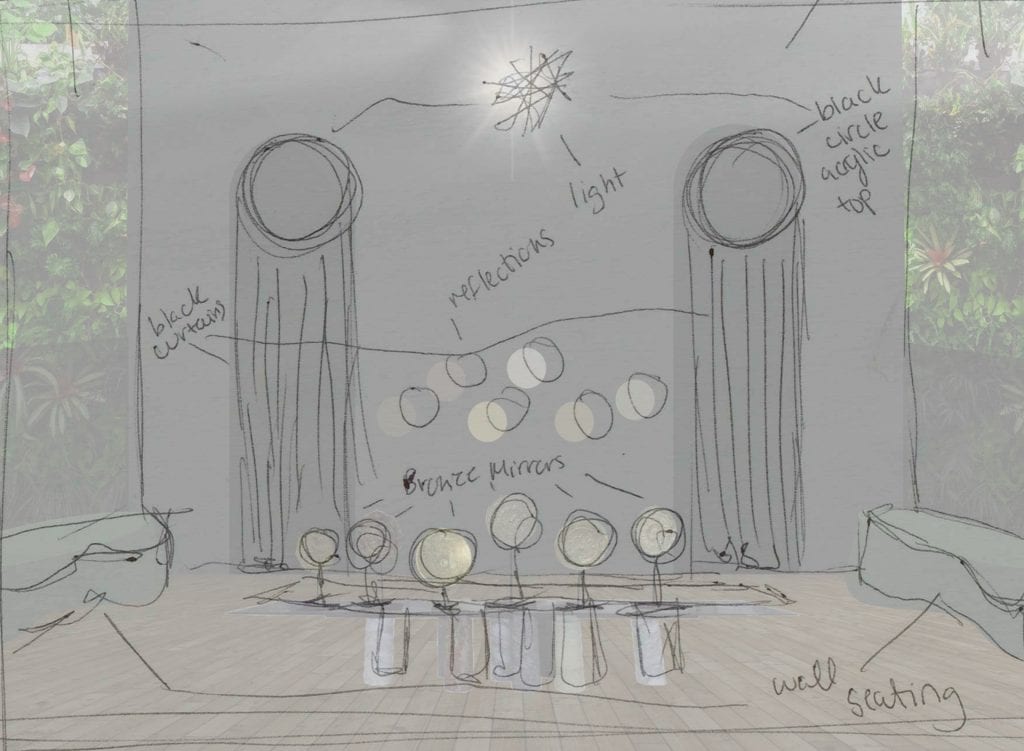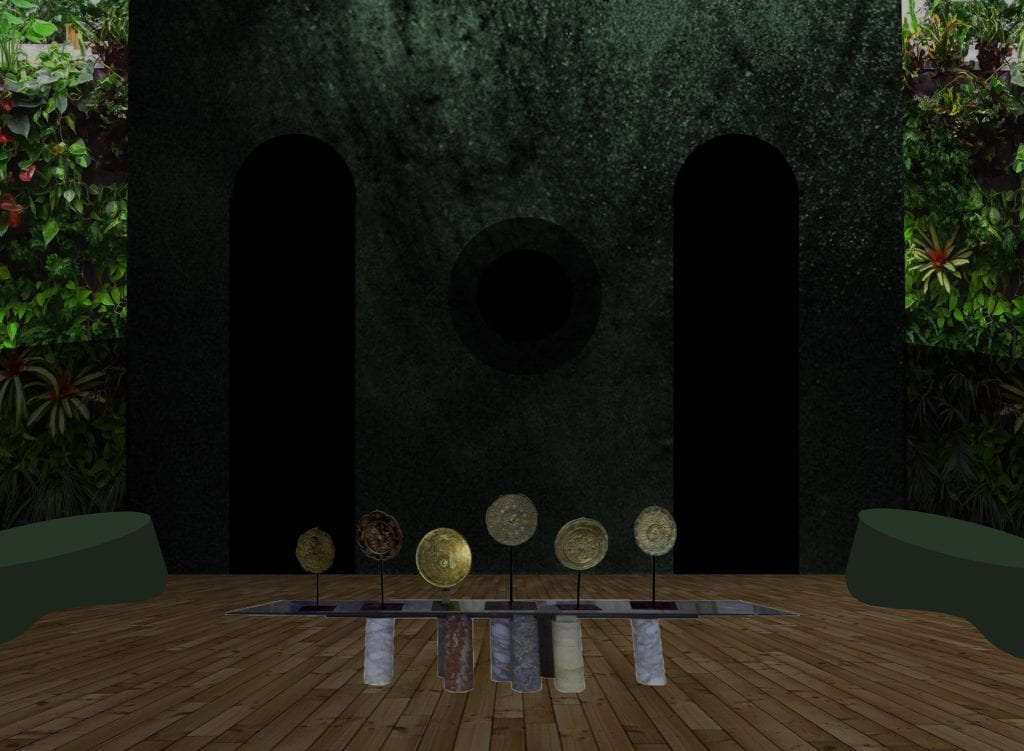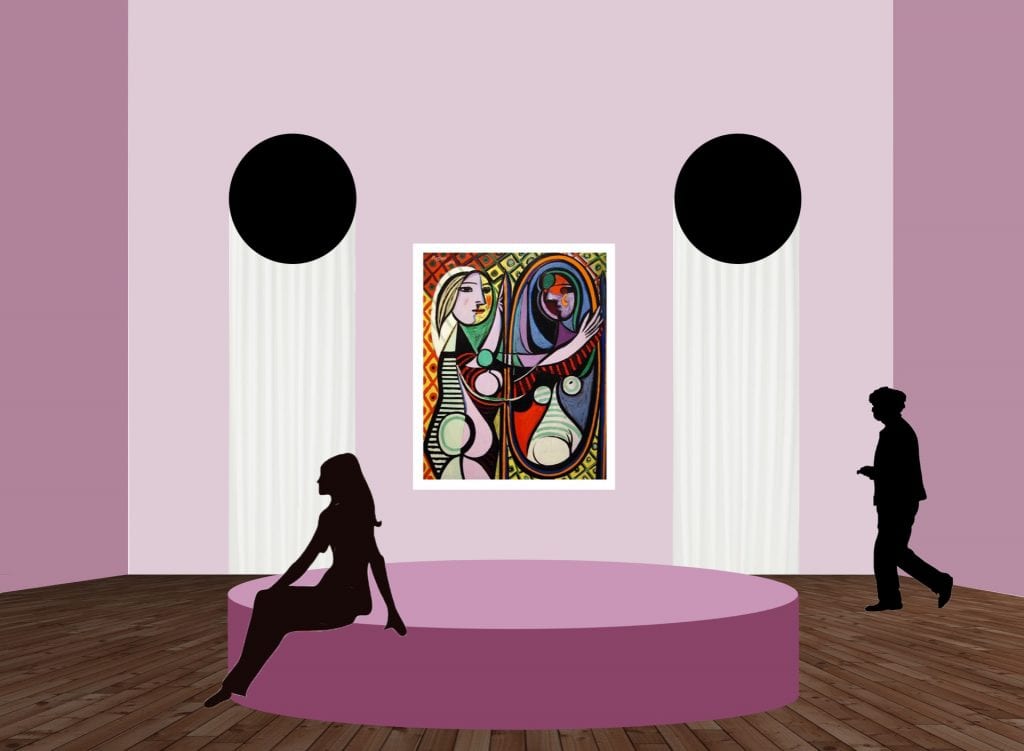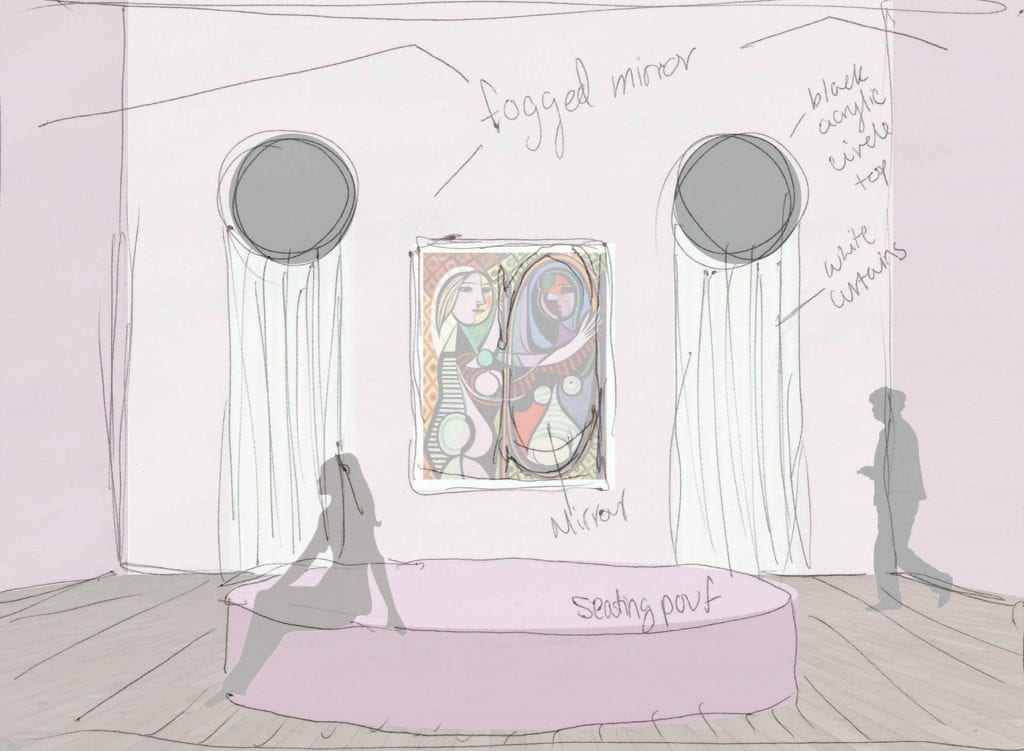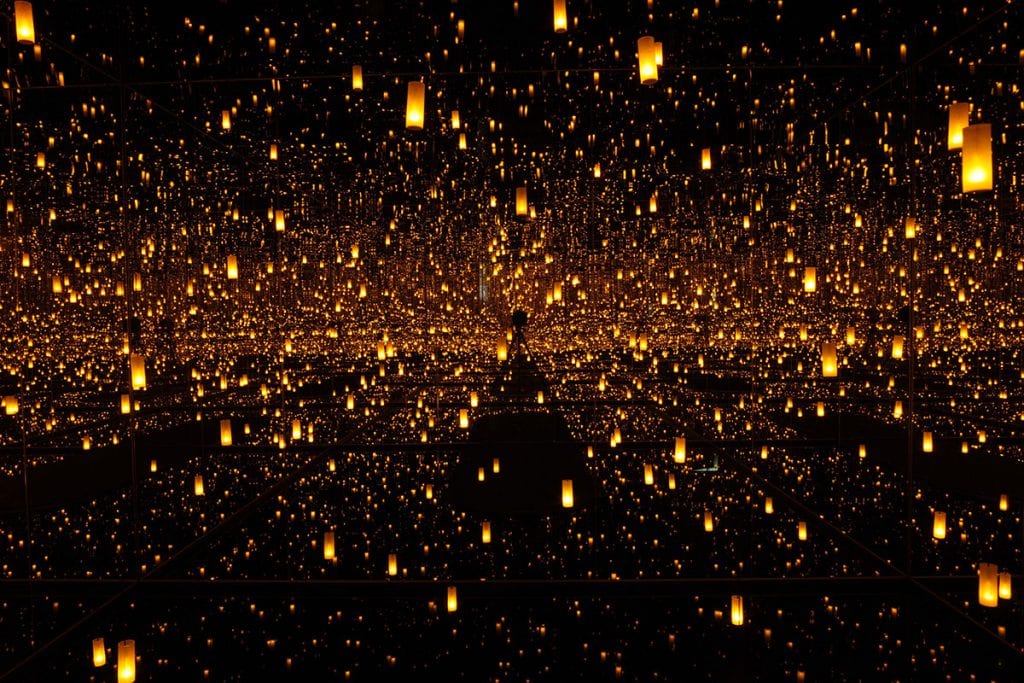An Echo of Light
Lighting Design & Floor Plan:
———————————————————————————————————————
The word reflection kept bouncing around my head after I had googled the definition of a mirror. I thought about how a mirror echoes the light it is reflecting, hence the title of my piece. I wanted the entrance of the exhibit to actually play off the title of the exhibit. I began to write down all the ideas and names that came to me. Among them was the name, James Turrell. I saw his installations at MASS MoCA and was instantly inspired as to how I could tie his manipulation of light into this exhibit. I began to look at the Roden Crater in Arizona. When I came across the Alpha (East) Tunnel, it reflected everything that I could hope to encapsulate for an entrance to this exhibit. The reoccurring shape, that reminds me of a keyhole, puts a visual to an echo. Above the tunnel, three dimensional (3D) letters would be attached to the wall, and the lighting could play with the shadows that the 3D letters can create.
———————————————————————————————————————
Bronze Mirrors – Tang Dynasty China ‘618-907 AD’ (Non-European Object)
“Chinese mirrors typically have one smooth, plain face that was highly polished to a reflective surface. The other side was frequently embellished with lively decorative motifs. Both Han and Tang mirrors are considered to be the most technically advanced. A cord threaded through a hole in the central knob on the back made it easier to hold or carry. Large mirrors were often placed on a stand, and the smallest ones could be kept in the wide sleeve of a garment.
The Chinese magic mirror is an ancient art that can be traced back to the Chinese Han dynasty (206 BC – 24 AD). The mirrors were made out of solid bronze. The front is a shiny polished surface and could be used as a mirror, while the back has a design cast in the bronze. When bright sunlight or other bright light reflects onto the mirror, the mirror seems to become transparent. If that light is reflected from the mirror towards a wall, the pattern on the back of the mirror is then projected onto the wall.
They were used not only as functional artifacts but also as sacred objects. The Chinese believed mirrors not only reflected light but also had the ability to radiate it and thus illuminate the tomb for eternity. Often multiple mirrors were entombed close to the body of the deceased. They were also considered powerful talismans that would let you see into the spirit world.” – 1st Dibs
Bronze Mirrors Room
“Deep shadows and darkness are essential, because they dim the sharpness of vision, make depth and distance ambiguous, and incite unconscious peripheral vision and tactile fantasy.” – Pallasmaa The Eyes of The Skin
The room is designed to be lit with a dim lighting. The color scheme is predominately darker, varying in hues from a mid green to an elusive black. At the center, a table is set up with the bronze mirrors resting atop. A light would reflect the surface pattern of the mirror on to the east wall.
The first five feet of the north and south facing walls have mirror panels attached to them, the mirrors are fogged with a dark black/grey sheer cover. The top seven feet would be adorned by living walls. Along the north and south walls, a custom curved seating installation will be attached from the ground to two feet up.
The east and west walls both have doorways. The east wall is mirrored as well, covered with the same sheer covering as the north and south walls. The west wall will be covered with some kind of tactile material.
———————————————————————————————————————
A Girl Before A Mirror (European Object)
“Girl Before a Mirror was painted during Picasso’s cubism period. When you look closely at the image, you can interpret many different symbols within different parts of the painting. The woman’s face for one is painted with a side profile and a full frontal image. One side shows the daytime where she seems more like a woman, dolled up with her make up done. The other side with the rough charcoal texture portrays her at night. When she takes off the mask of makeup and is more vulnerable as a young lady. One way of interpreting the painting is when the woman looks at herself in the mirror; she is seeing herself as an old woman. From the green discoloration on her forehead, darkening of her facial features to the lines that show that her young body has been distorted, and gravity has taken its rightful place. Another way of viewing the painting is that she is self-conscious, and she sees all the flaws in herself that the world doesn’t see.” – Pablo Picasso.org
A Girl Before A Mirror Room
“A [room] is not an end in itself; it frames, articulates, structures, gives significance, relates, separates and unites, facilitates and prohibits.” – Pallasmaa The Eyes of The Skin
The room should elicit a mellow atmosphere. All four walls will have mirrors attached to them, the mirrors will be fogged with a sheer white coating. The ceiling is inlaid with a light space inspired by James Turrell’s Shadow Space Constructions and Skylight Series.
In the center of the room there would be a large seating area that would actually be a large cylinder seat with a radius of about 10’ or perhaps more. People would be able to enjoy the painting as well as the atmosphere created by the lights and mirrors while resting on this lounge area.
———————————————————————————————————————
“Aftermath of Obliteration of Eternity” 2009 – Yayoi Kusama (Present Day Object)
“Expanding upon her lifelong obsession with the dissolution of the self into the infinite, Yayoi Kusama created “Aftermath of Obliteration of Eternity” the year of her 80th birthday. Viewers are invited to step into the room and stand on the central platform. Over time a delicate, shimmering mirage unfolds, as an array of lights ignites and is mirrored on every surface of the all-encompassing environment. In less than a minute, however, all light disappears, and then the cycle starts anew. Kusama explains: “Life is what I always try to understand—its depths and its mystique of rise and fall. I struggle for it throughout my life. From day to day, I understand the greatness brought by this mystique as well as that love is eternal and keeps appearing and disappearing. And what is more, I am very pleased to be alive after realizing that I have overcome this everyday life and been able to reach today. Yet we keep flashing, disappearing, and again blossoming out in this Eternity.” – Museum of Fine Art Houston
“Aftermath of Obliteration of Eternity” Room
This room would be entirely conceptualized by Yayoi Kusama, I would want to stay true to her vision. It would be the final room in the exhibition.
———————————————————————————————————————
Sources :
The Eyes of The Skin by Juhani Pallasmaa
https://www.mfah.org/art/detail/131625
https://www.1stdibs.com/furniture/asian-art-furniture/antiquities/tang-dynasty-bronze-mirror-set-china-618-907-ad/idf_10947221/?gclid=EAIaIQobChMIsfOh64uH3wIVQUGGCh3UAg32EAQYAiABEgJgGfD_BwE&gclsrc=aw.ds
https://www.moma.org/collection/works/78311
https://www.pablopicasso.org/girl-before-mirror.jsp
